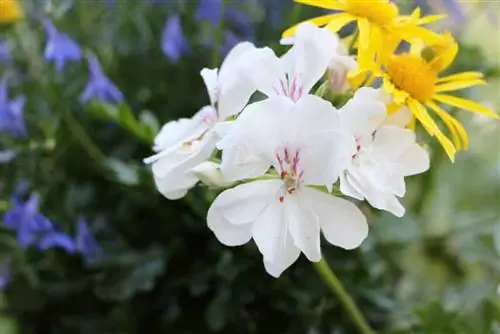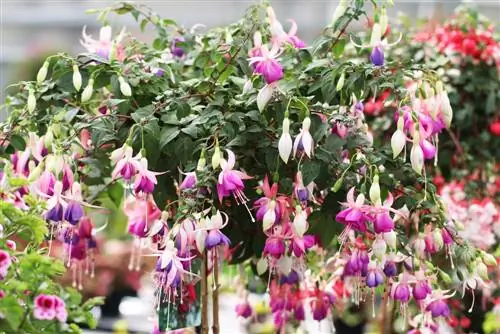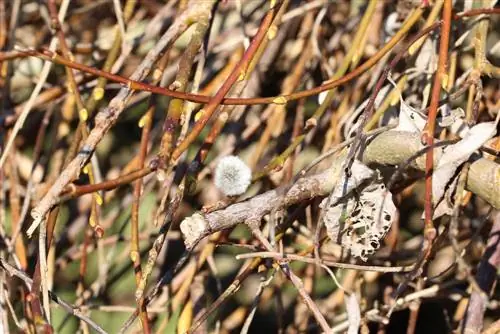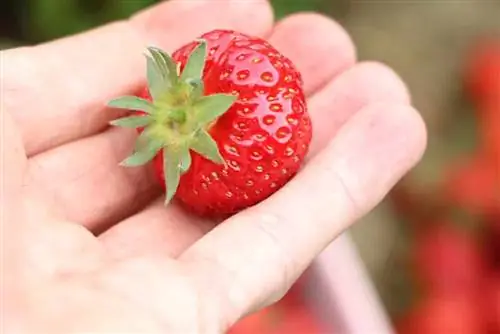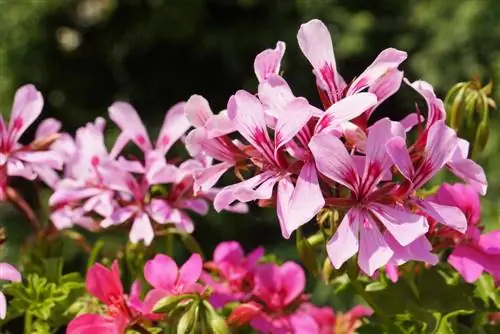- Author admin [email protected].
- Public 2023-12-17 03:39.
- Last modified 2025-01-24 12:45.
Hanging geraniums take over the balcony from May onwards and make it shine colorfully for months. The meter-long tendrils covered in flowers cannot be overlooked, even from a distance. In winter, however, they can no longer offer their color and scent spectacle because they cannot tolerate frost. Since hanging geraniums are naturally perennial, you should overwinter them if possible. We reveal how!
Observe temperature values
Hanging geraniums, also known as hanging pelargoniums, are not hardy. In a protected location they can only survive light frosts. Otherwise, they must be brought to safety in good time from sub-zero temperatures. Admitting them too early is not ideal either. It strengthens these plants if they stay outside as long as possible. Until the temperature drops permanently around 5 °C. Since the onset of winter comes at a different time every year and there are also regional differences, you should keep an eye on the thermometer and follow weather forecasts. So you definitely won't miss the right time to move.
Put away with flower box
If the flower boxes are mobile or can be easily removed from the balcony railing, the hanging pelargoniums should remain in them. They are brought to winter quarters together with their root dwellings. This also applies to hanging geraniums that hang in a pot from the balcony ceiling.
Dig up balcony geraniums as an alternative
If the balcony boxes are so firmly attached to the balcony that they cannot be moved to another location, the geraniums must be dug up if they are to bloom again the following year. Even if the winter quarters are not large enough to accommodate the rather bulky flower boxes, digging them out is the only way to get the plants safely through the winter.
However, digging up a geranium must be done very carefully so that the root ball is not damaged. First, however, their tendrils are shortened significantly until only 2-3 thickened areas remain per tendril. The plant will sprout again from these thickened areas in the spring.
Note:
The cut tendrils provide good propagation material. Autumn is also the ideal time of year to propagate these frequent bloomers from cuttings. In this way, even the last green gap on the balcony can be closed.
Putting dug up geraniums in flower pot
There are various ways in which dug-out hanging geraniums can move into winter quarters. We recommend this approach:
- take a larger pot
- put some potting soil in it
- Place the roots close together
Keep blooming in the house
Hanging geraniums, which you can put away with a pot or balcony box, can overwinter warmly in living rooms. If no other wintering quarters are available, this is a great advantage. In a bright window seat, the plants, which originally come from South Africa, will not take a winter break and will continue to delight us with their flowers, even if they appear more sparsely than in summer. Of course, the usual care must still be provided in a bright and warm winter location.
Note:
A warm room is not suitable for overwintering excavated specimens. A cooler place must be found for you. Luckily, their accommodation doesn't take up much space.
Winter hanging geraniums frost-free and brightly
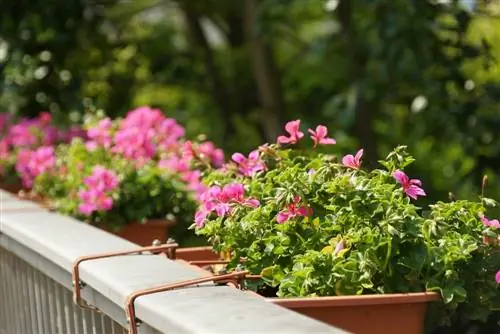
Hanging geraniums are usually cultivated in large numbers to immerse the balcony in a sea of color over the summer. In winter, however, they shouldn't play a major role. There will also rarely be an opportunity to let them continue to grow and bloom indoors. Typical is a “barren” winter in a cool, frost-free area that is ideally also bright. Then these balcony plants will even continue to open some flowers. A good neighborhood is, for example:
- a cellar with light coming in
- bright staircase
- Garage with window
Make sure the temperature is even
It is important that the winter quarters are not only frost-free, but also that the temperature does not fluctuate too much. Values between 5 and 10 ° C are ideal. Do not place the hanging pelargoniums too close to the window so that you do not feel direct sun on sunny days.
Alternatively winter in the dark
Some basement rooms have no window or only a little light comes in. However, they cannot be ruled out as winter quarters for hanging geraniums, even if they are only a second choice. However, the lack of light forces us to cut the plants back heavily before putting them away. All leaves are also removed. You don't have to worry about major flower losses in the following growing season, because hanging geraniums bloom on new shoots. Pruning even promotes abundant branching.
Cut back if space is limited
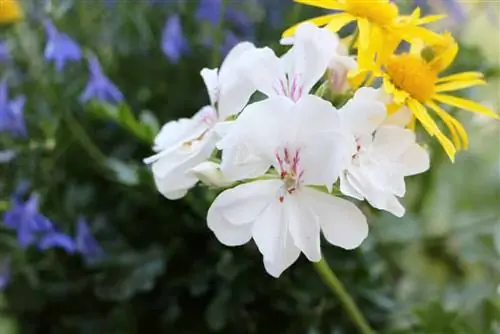
Hanging pelargoniums are not the only plants cultivated in this country that come from warm regions of the world. It may be that in autumn many plants have to share a common winter quarters. Sometimes it can get very tight.
- Cut back pelargoniums before putting them away
- modest or strong as necessary
- However, each tendril should still retain 2-3 thickened areas
- this shows the new growth in spring
Pouring reduced maintained
Even in winter quarters, watering hanging pelargoniums should not be stopped completely. However, their extent depends heavily on the winter quarters. It also plays a role whether and to what extent the plants were cut back.
- the brighter and warmer the location, the higher the moisture requirement
- the more you cut back, the less water you need
- water as needed without causing waterlogging
- it can cause rot
- the soil should always be slightly moist
- pour something every now and then even in dark rooms
Note:
Pelargoniums that are kept cool and that are heavily pruned do not require large amounts of nutrients, which is why they must not be fertilized in winter. Only if a plant continues to grow and bloom in a warm room should it receive some liquid fertilizer at regular intervals.
Check for pests
In their winter quarters, especially when it comes to basements, hanging geraniums have disappeared from our sight. However, regular inspection makes sense because pests pose a danger, especially during wintering. Aphids and spider mites can feast on plants that have not been cut back. A possible infestation must be discovered and combated early so that hanging geraniums and other overwintering plants do not suffer any damage.
End wintering in time
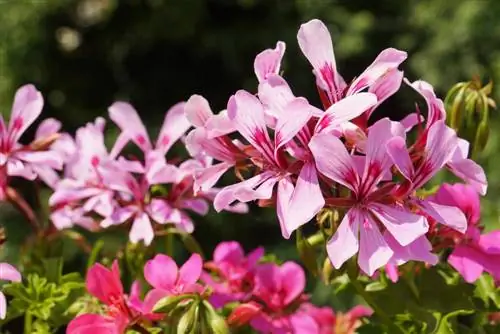
Every plant owner knows that there is only guaranteed freedom from frost outdoors from mid-May. We should still turn to these overwintered balcony plants earlier. Pelargoniums that have previously been dug up must be freed from their cramped quarters and the neighborhood with other specimens.
- trade around February
- separating individual plants
- plant each in its own pot
- make it warmer and brighter
- Repot overwintered plants in pots if necessary
- usually only necessary every few years
- if the root ball gets too big
- cut back all tendrils to about 10 cm
- unless this has already happened in the fall
From now on the geraniums will be watered more frequently again, because in a warmer place new growth won't take long to appear. Take into account their sensitivity to waterlogging. It is better to water more often with little water.
Bringing pelargoniums to the balcony
Even if frost-sensitive plants are generally only safe outside after the Ice Saints, hanging geraniums can welcome an early arrival of spring on the balcony before this date. But not without gradually getting used to the sun's rays. However, experienced gardeners are not deterred by the sun and are aware that unexpected frosts can still come. Then the balcony plants have to retreat again.
Note:
Did you know that with each successful overwintering the geraniums become stronger and increase in flower density? That alone is a good argument not to sacrifice these plants to frost.

